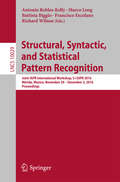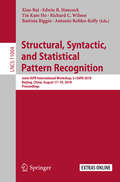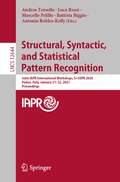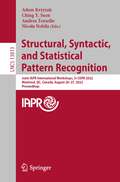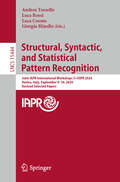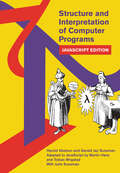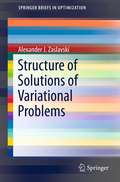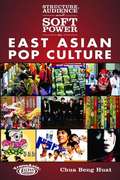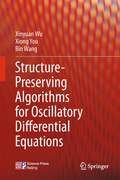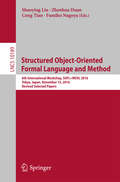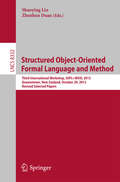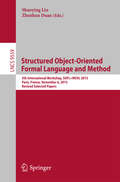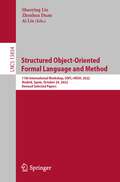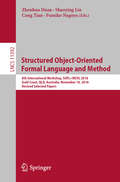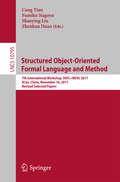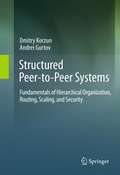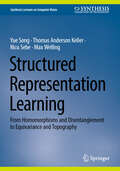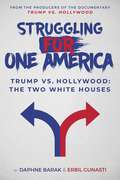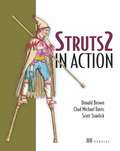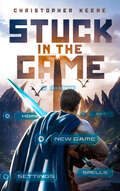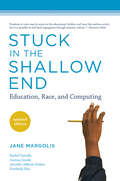- Table View
- List View
Structural, Syntactic, and Statistical Pattern Recognition: Joint IAPR International Workshop, S+SSPR 2016, Mérida, Mexico, November 29 - December 2, 2016, Proceedings (Lecture Notes in Computer Science #10029)
by Antonio Robles-Kelly, Marco Loog, Battista Biggio, Francisco Escolano and Richard WilsonThis book constitutes the proceedings of the Joint IAPR International Workshop on Structural Syntactic, and Statistical Pattern Recognition, S+SSPR 2016, consisting of the International Workshop on Structural and Syntactic Pattern Recognition SSPR, and the International Workshop on Statistical Techniques in Pattern Recognition, SPR. The 51 full papers presented were carefully reviewed and selected from 68 submissions. They are organized in the following topical sections: dimensionality reduction, manifold learning and embedding methods; dissimilarity representations; graph-theoretic methods; model selection, classification and clustering; semi and fully supervised learning methods; shape analysis; spatio-temporal pattern recognition; structural matching; text and document analysis.
Structural, Syntactic, and Statistical Pattern Recognition: Joint IAPR International Workshop, S+SSPR 2018, Beijing, China, August 17–19, 2018, Proceedings (Lecture Notes in Computer Science #11004)
by Antonio Robles-Kelly Richard C. Wilson Xiao Bai Battista Biggio Edwin R. Hancock Tin Kam HoThis book constitutes the proceedings of the Joint IAPR International Workshop on Structural, Syntactic, and Statistical Pattern Recognition, S+SSPR 2018, held in Beijing, China, in August 2018.The 49 papers presented in this volume were carefully reviewed and selected from 75 submissions. They were organized in topical sections named: classification and clustering; deep learning and neurla networks; dissimilarity representations and Gaussian processes; semi and fully supervised learning methods; spatio-temporal pattern recognition and shape analysis; structural matching; multimedia analysis and understanding; and graph-theoretic methods.
Structural, Syntactic, and Statistical Pattern Recognition: Joint IAPR International Workshops, S+SSPR 2020, Padua, Italy, January 21–22, 2021, Proceedings (Lecture Notes in Computer Science #12644)
by Antonio Robles-Kelly Luca Rossi Marcello Pelillo Battista Biggio Andrea TorselloThis book constitutes the proceedings of the Joint IAPR International Workshop on Structural, Syntactic, and Statistical Pattern Recognition, S+SSPR 2020, held in Padua, Italy, in January 2021. The 35 papers presented in this volume were carefully reviewed and selected from 81 submissions. The accepted papers cover the major topics of current interest in pattern recognition, including classification and clustering, deep learning, structural matching and graph-theoretic methods, and multimedia analysis and understanding.
Structural, Syntactic, and Statistical Pattern Recognition: Joint IAPR International Workshops, S+SSPR 2022, Montreal, QC, Canada, August 26–27, 2022, Proceedings (Lecture Notes in Computer Science #13813)
by Ching Y. Suen Adam Krzyzak Andrea Torsello Nicola NobileThis book constitutes the proceedings of the Joint IAPR International Workshop on Structural, Syntactic, and Statistical Pattern Recognition, S+SSPR 2022, held in Montreal, QC, Canada, in August 2022.The 30 papers together with 2 invited talks presented in this volume were carefully reviewed and selected from 50 submissions. The workshops presents papers on topics such as deep learning, processing, computer vision, machine learning and pattern recognition and much more.
Structural, Syntactic, and Statistical Pattern Recognition: Joint IAPR International Workshops, S+SSPR 2024, Venice, Italy, September 9–10, 2024, Revised Selected Papers (Lecture Notes in Computer Science #15444)
by Luca Rossi Andrea Torsello Luca Cosmo Giorgia MinelloThis book constitutes the proceedings of the Joint IAPR International Workshops on Structural, Syntactic, and Statistical Pattern Recognition, S+SSPR 2024, which took place in Venice, Italy, during September 9-11, 2024. The 19 full papers presented in this volume were carefully reviewed and selected from 27 submissions. The proceedings focus on pattern recognition, including classification and clustering, deep learning, structural matching and graph-theoretic methods, and multimedia analysis and understanding.
Structure and Interpretation of Computer Programs: JavaScript Edition (MIT Electrical Engineering and Computer Science)
by Harold Abelson Gerald Jay SussmanA new version of the classic and widely used text adapted for the JavaScript programming language.Since the publication of its first edition in 1984 and its second edition in 1996, Structure and Interpretation of Computer Programs (SICP) has influenced computer science curricula around the world. Widely adopted as a textbook, the book has its origins in a popular entry-level computer science course taught by Harold Abelson and Gerald Jay Sussman at MIT. SICP introduces the reader to central ideas of computation by establishing a series of mental models for computation. Earlier editions used the programming language Scheme in their program examples. This new version of the second edition has been adapted for JavaScript. The first three chapters of SICP cover programming concepts that are common to all modern high-level programming languages. Chapters four and five, which used Scheme to formulate language processors for Scheme, required significant revision. Chapter four offers new material, in particular an introduction to the notion of program parsing. The evaluator and compiler in chapter five introduce a subtle stack discipline to support return statements (a prominent feature of statement-oriented languages) without sacrificing tail recursion. The JavaScript programs included in the book run in any implementation of the language that complies with the ECMAScript 2020 specification, using the JavaScript package sicp provided by the MIT Press website.
Structure of Solutions of Variational Problems
by Alexander J. ZaslavskiStructure of Solutions of Variational Problems is devoted to recent progress made in the studies of the structure of approximate solutions of variational problems considered on subintervals of a real line. Results on properties of approximate solutions which are independent of the length of the interval, for all sufficiently large intervals are presented in a clear manner. Solutions, new approaches, techniques and methods to a number of difficult problems in the calculus of variations are illustrated throughout this book. This book also contains significant results and information about the turnpike property of the variational problems. This well-known property is a general phenomenon which holds for large classes of variational problems. The author examines the following in relation to the turnpike property in individual (non-generic) turnpike results, sufficient and necessary conditions for the turnpike phenomenon as well as in the non-intersection property for extremals of variational problems. This book appeals to mathematicians working in optimal control and the calculus as well as with graduate students.
Structure, Audience and Soft Power in East Asian Pop Culture
by Chua Beng HuatEast Asian pop culture can be seen as an integrated cultural economy emerging from the rise of Japanese and Korean pop culture as an influential force in the distribution and reception networks of Chinese language pop culture embedded in the ethnic Chinese diaspora. Taking Singapore as a locus of pan-Asian Chineseness, Chua Beng Huat provides detailed analysis of the fragmented reception process of transcultural audiences and the processes of audiences' formation and exercise of consumer power and engagement with national politics. In an era where exercise of military power is increasingly restrained, pop culture has become an important component of soft power diplomacy and transcultural collaborations in a region that is still haunted by colonization and violence. The author notes that the aspirations behind national governments' efforts to use popular culture is limited by the fragmented nature of audiences who respond differently to the same products; by the danger of backlash from other members of the importing country's population that do not consume the popular culture products in question; and by the efforts of the primary consuming country, the People's Republic of China to shape products through co-production strategies and other indirect modes of intervention.
Structure-Preserving Algorithms for Oscillatory Differential Equations
by Bin Wang Xiong You Xinyuan WuStructure-Preserving Algorithms for Oscillatory Differential Equations describes a large number of highly effective and efficient structure-preserving algorithms for second-order oscillatory differential equations by using theoretical analysis and numerical validation. Structure-preserving algorithms for differential equations, especially for oscillatory differential equations, play an important role in the accurate simulation of oscillatory problems in applied sciences and engineering. The book discusses novel advances in the ARKN, ERKN, two-step ERKN, Falkner-type and energy-preserving methods, etc. for oscillatory differential equations. The work is intended for scientists, engineers, teachers and students who are interested in structure-preserving algorithms for differential equations. Xinyuan Wu is a professor at Nanjing University; Xiong You is an associate professor at Nanjing Agricultural University; Bin Wang is a joint Ph.D student of Nanjing University and University of Cambridge.
Structured Object-Oriented Formal Language and Method
by Shaoying Liu Zhenhua Duan Cong Tian Fumiko NagoyaThis book constitutes the thoroughly refereed post-workshop proceedings of the 5th International Workshop on Structured Object-Oriented Formal Language and Method, SOFL+MSVL 2015, held in Paris, France, in November 2015. The 15 papers presented in this volume were carefully reviewed and selected from 22 submissions. The focus of this workshops was on following subjects: Modeling, specification, verification, model checking, testing, debugging, transformation, and algorithm.
Structured Object-Oriented Formal Language and Method
by Shaoying Liu Zhenhua DuanThis book constitutes the thoroughly refereed post-workshop proceedings of the 4th International Workshop on Structured Object-Oriented Formal Language and Method, SOFL+MSVL 2014, held in Luxembourg, Luxembourg, in November 2014. The 12 papers presented in this volume were carefully reviewed and selected from 20 submissions. They are organized in topical sections on testing and inspection; model checking and animation; education and verification; and semantics and analysis.
Structured Object-Oriented Formal Language and Method
by Shaoying Liu Zhenhua DuanThis book constitutes the thoroughly refereed post-workshop proceedings of the 5th International Workshop on Structured Object-Oriented Formal Language and Method, SOFL+MSVL 2015, held in Paris, France, in November 2015. The 15 papers presented in this volume were carefully reviewed and selected from 22 submissions. The focus of this workshops was on following subjects: Modeling, specification, verification, model checking, testing, debugging, transformation, and algorithm.
Structured Object-Oriented Formal Language and Method: 10th International Workshop, SOFL+MSVL 2020, Singapore, March 1, 2021, Revised Selected Papers (Lecture Notes in Computer Science #12723)
by Shaoying Liu Zhenhua Duan Jinyun Xue Fumiko NagoyaThis book constitutes the refereed workshop proceedings of the 10th International Workshop on Structured Object-Oriented Formal Language and Method, SOFL+MSVL 2020, held in Singapore, in March 2021. The 13 revised full papers included in the volume were carefully reviewed and selected from 24 submissions. They are organized in the following topical sections: modeling and specification; model checking; specification and verification; and testing and formal verification.Due to the Corona pandemic this event was held virtually.
Structured Object-Oriented Formal Language and Method: 11th International Workshop, SOFL+MSVL 2022, Madrid, Spain, October 24, 2022, Revised Selected Papers (Lecture Notes in Computer Science #13854)
by Shaoying Liu Zhenhua Duan Ai LiuThis book constitutes the refereed workshop proceedings of the 11th International Workshop on Structured Object-Oriented Formal Language and Method, SOFL+MSVL 2022, held in Madrid, in October 2022.The 12 revised full papers included in the volume were carefully reviewed and selected from 26 submissions. They are organized in the following topical sections: Model Checking & Markov Decision Process; Model Analysis & Tool Implementation; Formal Specification & Testing; Algorithms & Verification. .
Structured Object-Oriented Formal Language and Method: 8th International Workshop, SOFL+MSVL 2018, Gold Coast, QLD, Australia, November 16, 2018, Revised Selected Papers (Lecture Notes in Computer Science #11392)
by Shaoying Liu Zhenhua Duan Cong Tian Fumiko NagoyaThis book constitutes the thoroughly refereed workshop proceedings of the 8th International Workshop on Structured Object-Oriented Formal Language and Method, SOFL+MSVL 2018, held in Gold Coast, QLD, Australia, in November 2018.The 11 revised full papers included in the volume were carefully reviewed and selected from 21 submissions. They are organized in the following topical sections: programming and testing; verification and validation; semantics; and blockchain.
Structured Object-Oriented Formal Language and Method: 9th International Workshop, SOFL+MSVL 2019, Shenzhen, China, November 5, 2019, Revised Selected Papers (Lecture Notes in Computer Science #12028)
by Shaoying Liu Zhenhua Duan Cong Tian Huaikou MiaoThis book constitutes the thoroughly refereed workshop proceedings of the 9th International Workshop on Structured Object-Oriented Formal Language and Method, SOFL+MSVL 2019, held in Shenzhen, China, in November 2019. The 23 revised full papers included in the volume were carefully reviewed and selected from 43 submissions. They are organized in the following topical sections: testing and debugging, formal verification, problem solving, software analysis and evolution, and software analysis and testing.
Structured Object-Oriented Formal Language and Method: Third International Workshop, Sofl+msvl 2013, Queenstown, New Zealand, October 29, 2013, Revised Selected Papers (Lecture Notes in Computer Science #8332)
by Shaoying Liu Zhenhua Duan Cong Tian Fumiko NagoyaThis book constitutes the thoroughly refereed workshop proceedings of the 7th International Workshop on Structured Object-Oriented Formal Language and Method, SOFL+MSVL 2017, held in Xi’an, China, in November 2017. The 13 revised full papers included in the volume were carefully reviewed and selected from 21 submissions. They are organized in the following topical sections: animation and prototyping; graph theory; model checking; modeling and specification; and verification and validation.
Structured Peer-to-Peer Systems
by Dmitry Korzun Andrei GurtovThe field of structured P2P systems has seen fast growth upon the introduction of Distributed Hash Tables (DHTs) in the early 2000s. The first proposals, including Chord, Pastry, Tapestry, were gradually improved to cope with scalability, locality and security issues. By utilizing the processing and bandwidth resources of end users, the P2P approach enables high performance of data distribution which is hard to achieve with traditional client-server architectures. The P2P computing community is also being actively utilized for software updates to the Internet, P2PSIP VoIP, video-on-demand, and distributed backups. The recent introduction of the identifier-locator split proposal for future Internet architectures poses another important application for DHTs, namely mapping between host permanent identity and changing IP address. The growing complexity and scale of modern P2P systems requires the introduction of hierarchy and intelligence in routing of requests. Structured Peer-to-Peer Systems covers fundamental issues in organization, optimization, and tradeoffs of present large-scale structured P2P systems, as well as, provides principles, analytical models, and simulation methods applicable in designing future systems. Part I presents the state-of-the-art of structured P2P systems, popular DHT topologies and protocols, and the design challenges for efficient P2P network topology organization, routing, scalability, and security. Part II shows that local strategies with limited knowledge per peer provide the highest scalability level subject to reasonable performance and security constraints. Although the strategies are local, their efficiency is due to elements of hierarchical organization, which appear in many DHT designs that traditionally are considered as flat ones. Part III describes methods to gradually enhance the local view limit when a peer is capable to operate with larger knowledge, still partial, about the entire system. These methods were formed in the evolution of hierarchical organization from flat DHT networks to hierarchical DHT architectures, look-ahead routing, and topology-aware ranking. Part IV highlights some known P2P-based experimental systems and commercial applications in the modern Internet. The discussion clarifies the importance of P2P technology for building present and future Internet systems.
Structured Representation Learning: From Homomorphisms and Disentanglement to Equivariance and Topography (Synthesis Lectures on Computer Vision)
by Nicu Sebe Max Welling Yue Song Thomas Anderson KellerThis book introduces approaches to generalize the benefits of equivariant deep learning to a broader set of learned structures through learned homomorphisms. In the field of machine learning, the idea of incorporating knowledge of data symmetries into artificial neural networks is known as equivariant deep learning and has led to the development of cutting edge architectures for image and physical data processing. The power of these models originates from data-specific structures ingrained in them through careful engineering. To-date however, the ability for practitioners to build such a structure into models is limited to situations where the data must exactly obey specific mathematical symmetries. The authors discuss naturally inspired inductive biases, specifically those which may provide types of efficiency and generalization benefits through what are known as homomorphic representations, a new general type of structured representation inspired from techniques in physics and neuroscience. A review of some of the first attempts at building models with learned homomorphic representations are introduced. The authors demonstrate that these inductive biases improve the ability of models to represent natural transformations and ultimately pave the way to the future of efficient and effective artificial neural networks.
Struggling for One America: Trump vs. Hollywood: The Two White Houses
by Daphne Barak Erbil GunastiWhat happens when you speak with Hollywood stars and entertainers—half pro-Trump and half against—posting the question, &“Can we talk?&” Since the 2016 presidential campaigns, Conservatives, Liberals, Democrats, Republicans, Whites, and non-Whites in America began saying loudly that they are &“Fighting for America.&” Yet, by the 2020 presidential elections, they were even more divided than united despite all the good intention of the most. Now that America is well into 2021, it is time to yearn for &“One America&” but without &“fighting.&” But here is the caveat! To achieve &“One America,&” the &“Trump Phenomena&” must first be understood. Next, &“Discrimination&” and &“Racism&” in America must be re-visited. After that, &“Cancel Culture&” and &“No-No Rhetoric&” must be handled promptly and sensitively. Finally, Hollywood must first embrace #MeToo Movement and then come up with a long-term strategy. Filmmakers of the Trump vs. Hollywood documentary, Daphne Barak and Erbil Gunasti brought on board twenty-four Hollywood stars and entertainers in a documentary to discuss these topics. Half were chosen among pro-Trump, and half against. Daphne interviewed both sides, posing the question: &“Can We Talk?&”Struggling For One America stands as the genesis of this documentary. This book in that respect points at the presumptive and pretended &“Culprits&” and &“Scapegoats&” in the current divide, while focusing on what is obvious. The two White Houses are standing tall, in plain sight, and a step further on the wrong direction from this moment on would be nothing less than repeating history.
Struktur und Design responsiver Webseiten auf Smartphones: Wie Sie das mobile Internet userfreundlich gestalten (essentials)
by Annika BrinkmannAnnika Brinkmann zeigt in diesem essential, wie mit wenigen Kniffen aus schlechten Beispielen gute mobile Webseiten entstehen können. Die Autorin erläutert, was getan werden muss, um Inhalte nicht zu klein oder zu groß für den verfügbaren Platz darzustellen, Navigationen sinnvoll zu strukturieren und von der richtigen Seite her einzublenden. Kurzum: Sie zeigt, wie man mobile Websites übersichtlich gestaltet, damit diese keinen User-Frust auslösen. Das mobile Internet hat die Nutzung von Webseiten auf Desktop-Computern längst hinter sich gelassen. „Mobile first“ ist angesagt, die Zeichen stehen oftmals sogar auf „Mobile only“-Nutzung des Internets – zumindest im Privatgebrauch.
Struts 2 in Action
by Andrew Psaltis Chad Michael DavisThe original Struts project revolutionized Java web development and its rapid adoption resulted in the thousands of Struts-based applications deployed worldwide. Keeping pace with new ideas and trends, Apache Struts 2 has emerged as the product of a merger between the Apache Struts and OpenSymphony WebWork projects, united in their goal to develop an easy-to-use yet feature-rich framework. Struts 2 represents a revolution in design and ease of use when compared to classic Struts. It adds exciting and powerful features such as a plugin framework, JavaServer Faces integration, and XML-free configuration.Struts 2 In Action introduces the Apache Struts 2 web application framework and shows you how to quickly develop professional, production-ready modern web applications. Written by Don Brown, one of the leading developers of Struts 2, Chad Davis, a passionate Struts 2 developer, along with Scott Stanlick, this book gently walks you through the key features of Struts 2 in example-driven, easy-to-digest sections.Struts 2 in Action delivers accurate, seasoned information that can immediately be put to work. This book is designed for working Java web developers-especially those with some background in Struts 1 or WebWork. The core content, covering key framework components such as Actions, Results, and Interceptors, includes new features like the annotation-based configuration options. You'll find chapters on Struts 2 plugins, FreeMarker, and migration from Struts 1 and WebWork 2. Finally, new topics such as the Ajax tags, Spring Framework integration, and configuration by convention give familiar subjects new depth. Purchase of the print book comes with an offer of a free PDF, ePub, and Kindle eBook from Manning. Also available is all code from the book.
Stuck in the Game
by Christopher KeeneNoah promised himself he would never play the world&’s most popular MMORPG—the Dream State. He&’d already lost too many friends to the addictive virtual world. But after a devastating car crash leaves Noah paralyzed, he&’s forced inside the game. The Dream State not only provides a connection with the outside world but also keeps his brain awake long enough for his body to heal. Dying in the game, however, could send Noah into a coma forever. To stay safe, he must remain in the lower levels, far away from the most dangerous monsters and players. Meanwhile, doctors grow concerned when Noah&’s girlfriend, Sue—who also sustained serious injuries in the crash—seemingly fails to connect to the game. When a mysterious avatar suggests to Noah that the last remnants of Sue&’s consciousness are being held prisoner in the highest level, Noah decides to risk everything to save her. Leaving the safety of the lower levels, Noah rises through the ranks and enters the most dangerous part of the game, allying with high-level players and unearthing clues to a sinister plot along the way. Now top players from across the world are hunting him. With his life on the line, can Noah save Sue and uncover the mystery?
Stuck in the Shallow End
by Jane MargolisThe number of African Americans and Latino/as receiving undergraduate and advanced degrees in computer science is disproportionately low, according to recent surveys. And relatively few African American and Latino/a high school students receive the kind of institutional encouragement, educational opportunities, and preparation needed for them to choose computer science as a field of study and profession. In Stuck in the Shallow End,Jane Margolis looks at the daily experiences of students and teachers in three Los Angeles public high schools: an overcrowded urban high school, a math and science magnet school, and a well-funded school in an affluent neighborhood. She finds an insidious "virtual segregation" that maintains inequality. Two of the three schools studied offer only low-level, how-to (keyboarding, cutting and pasting) introductory computing classes. The third and wealthiest school offers advanced courses, but very few students of color enroll in them. The race gap in computer science, Margolis finds, is one example of the way students of color are denied a wide range of occupational and educational futures. Margolis traces the interplay of school structures (such factors as course offerings and student-to-counselor ratios) and belief systems--including teachers' assumptions about their students and students' assumptions about themselves. Stuck in the Shallow Endis a story of how inequality is reproduced in America--and how students and teachers, given the necessary tools, can change the system.
Stuck in the Shallow End, updated edition: Education, Race, and Computing
by Jane MargolisWhy so few African American and Latino/a students study computer science: updated edition of a book that reveals the dynamics of inequality in American schools.The number of African Americans and Latino/as receiving undergraduate and advanced degrees in computer science is disproportionately low. And relatively few African American and Latino/a high school students receive the kind of institutional encouragement, educational opportunities, and preparation needed for them to choose computer science as a field of study and profession. In Stuck in the Shallow End, Jane Margolis and coauthors look at the daily experiences of students and teachers in three Los Angeles public high schools: an overcrowded urban high school, a math and science magnet school, and a well-funded school in an affluent neighborhood. They find an insidious “virtual segregation” that maintains inequality. The race gap in computer science, Margolis discovers, is one example of the way students of color are denied a wide range of occupational and educational futures. Stuck in the Shallow End is a story of how inequality is reproduced in America—and how students and teachers, given the necessary tools, can change the system. Since the 2008 publication of Stuck in the Shallow End, the book has found an eager audience among teachers, school administrators, and academics. This updated edition offers a new preface detailing the progress in making computer science accessible to all, a new postscript, and discussion questions (coauthored by Jane Margolis and Joanna Goode).
